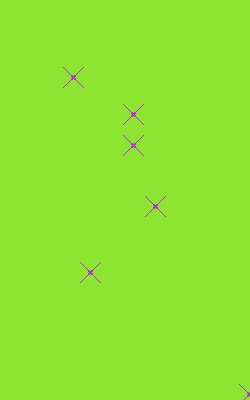Hmm, well; I used to write pieces of music as a wee kid; took a break out when doing the whole undergraduate thing – just tried to get back into it again this year – here’s a selection of (piano) stuff from when I was younger, and more recently (chronological order).
So, firstly some pieces from the olden days:
My first piece:
Something a little bangier:
Some etudes I wrote about the same time (number 9 is the best of them, the first section of which should be played with a sort of mechanical portato (okay, I find it really, really funny that spellcheckers and google insist that portato is a misspelling of potato. Why? Answers on a postcode)):
Study No. 6 ( ps | pdf | mp3 )
Study No. 9 ( ps | pdf | mp3 )
Study No. 14 ( ps | pdf )
Study No. 17 ( ps | pdf | mp3 )
When I decided to give writing a music a try again, I spent an entire weekend bashing away at the keyboard – I chuckle now hearing what I produced, especially given the great grief this output caused me, but I had to start again *somewhere*.
After this followed a glut of canons:
2-part Canon in the Minor Seventh ( ps | pdf )
2-part Canon in the Fourth ( ps | pdf )
2-part Canon in the Minor Ninth ( ps | pdf )
2-part Canon in the Octave No. 1 ( ps | pdf | mp3 )
2-part Canon in the Octave No. 2 ( ps | pdf | mp3 )
Three-part Canon ( ps | pdf )
I include only the right hand part of the following piece; the left hand is the right’s symmetrical image about middle C.
This is something pretty trivial. Feel like I should do something with the theme, though.
Then came a rather raggedy prelude:
Oh, I quite like this; probably my most tolerable pre-Christmas work; certainly the longest.
Henselt Variations ( ps | pdf | mp3 )
I wrote these “lullabies” either side of Christmas, though the first one is really more in the style of these patched-together pieces that come before, or Piece 1, but the other two are a littttle more successful I think.
Berceuse No. 1 ( ps | pdf )
Berceuse No. 2 ( ps | pdf )
Berceuse No. 3 ( ps | pdf )
Ah yes, then came our try at doing some jazz stuff…
Polonaise Sketch ( ps | pdf )
Arctic Sketch ( ps | pdf )
I don’t like this piece. It’s hard to play, and generally quite blah.
Hmmm, more of a ricercar, but I suppose that we’ll survive; I’m fond of some of the sonorities in it.
Fugue and Variations ( ps | pdf )
Hmm; I thought that I’d be able to do a lot with this theme, but in the end…didn’t, really.
Oh! I like this piece (in the last section of the mp3 file, the right hand part can’t be heard; I’ll have fix this some time) .
Hmm…don’t feel much about this piece either way, excepting it’s easy enough that I don’t have to feel bad about putting it up here.
Prelude and Canon ( ps | pdf | mp3 )
Not really enigmatic, but rather based around a password I would rather not forget. As it turned out, my encoding was a little, well, wrong, which caused me some small amount of embarrassment.
Hah. Someone used the term “rock epic” in response to one of the jazz sketches; I couldn’t resist rocking this prelude up a little bit. But the small mordant saves it from complete triviality. And what I would like to think is a tolerable fugue.
Prelude and Fugue in Bb – Prelude ( ps | pdf | mp3 )
Prelude and Fugue in Bb – Fugue ( ps | pdf | mp3 )
Hmm…two fugues, based on two arias from the Purcells’ “The Indian Queen”; the first one goes like
“Why, why, why should men quarrel
why should men quarrel here”.
The theme of the second fugue is based on an arias from the last section, a duet, with the lines quoted going,
Wife: My honey, my pug
Husband: My fetters, my clog
Wife: Let’s tamely jog on
Both: Let’s tamely jog on, as many other have done.
The last statement of this theme in the fugue continues the verse with the lines
Wife: And sometimes at quiet
Husband: but oftner at strife
Both: Let’s tug, let’s tug, the tedious, tedious load of our married life.
I find it a terribly, terribly endearing air.
Two Fugues from The Indian Queen No. 1 ( ps | pdf | mp3 )
Two Fugues from The Indian Queen No. 2 ( ps | pdf | mp3 )
Now this is a simple fugue I quite like. It strictly should be included in the 2001 batch of compositions I guess. Actually, I’ll tell the story. So I was all, like, loving all this counterpoint what was going around in the summer of 2001, and decided that it’d be just groovy if I could write a fugue. So I tried, and I was quite proud of my efforts, and I posted it to some website. And the dudes there were, like, “Dude, that’s nice, but it’s not a fugue”, and this frustrated me a little. I found myself remembering it last summer, and thought I’d like to root it out, but all I could find of it were some preliminary sketches of the theme and some other voices. I tried completing it as I remember it, but I wasn’t able to get it right. But there was enough to construct an actual fugue from it; it turned out okay! It was very satisfying.
And now for another bunch of fugues – the first one doesn’t have too much character other than a rhythmically off-putting countersubject really.
Fugue in A minor ( ps | pdf | mp3 )
Another Purcell-related fugue, this time “come come ye sons of art” from his music for the Queen’s birthday; pretty straightforward, if a little long, but nothing too jarringly unpleasant in it.
Fugue in C# major ( ps | pdf | mp3 )
The following fugue was lyrical enough that I couldn’t really resist tacking on a simple prelude based on a variation of that theme. I’m quite fond of some of the harmonies in the fugue.
Prelude and Fugue in G minor – Prelude ( ps | pdf )
Prelude and Fugue in G minor – Fugue ( ps | pdf | mp3 )
I amn’t quite able to decide whether the following fugue isn’t one of the must unmusical things I’ve written – it seems to have a certain dynamism, but…yeah…maybe I should blame it all on the countersubject… .
It is only with the disclaimer that I do not claim the following “fugues” to have any real merits beyond a certain playfulness that I you see them here; they themes (which are, along with the first countersubject, well over four years old) are belonging to a friend of mine who I have no doubt will sue me for billions and billions if he ever sees that I have put them up here; the first theme is clearly not fugue-material and comes out sounding for the most part quite computer-gamey (indeed, it made me feel that there might well be a few fugues lurking about in the megaman soundtracks, that I should check sometime), whilst the second is a little more conventional, but still pretty loosely tossed together.
Fugue on a theme of NS in E ( ps | pdf )
Fugue on a theme of NS in C ( ps | pdf | mp3)




